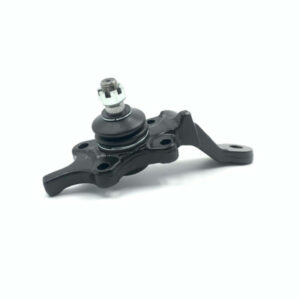A ball joint is used for allowing free rotation in two planes at the same time while preventing translation in any direction,[1] including rotating in those planes. Combining two such joints with control arms enables motion in all three planes, allowing the front end of an automobile to be steered and a spring and shock (damper) suspension to make the ride comfortable.
A simple kingpin suspension requires that the upper and lower control arms (wishbones) have pivot axes that are parallel, and in strict geometric relationship to the kingpin, or the top and bottom trunnions, which connect the kingpin to the control arms, would be severely stressed and the bearings would suffer severe wear. In practice, many vehicles had elastomeric bearings in the horizontal pivots of the trunnions, which allowed some small amount of flexibility, however this was insufficient to allow much adjustment of caster to be made, and also introduced compliance where the suspension designer may not have desired it in his quest for optimum handling. Camber angle could generally be adjusted by moving both inner pivots of either the upper or lower control arm inwards or outwards by an exactly equal amount. But compliance of the control arm inner pivots, typically due to the use of elastomeric bearings, would again cause the trunnions to be stressed. The suspension designer’s freedom was limited, it was necessary to have some compliance where it might not be wanted, and very little where more would have been useful in absorbing the fore and aft impact loading from bumps.
The introduction of ball joints top and bottom allowed 3-axis articulation and so removed all the constraints on the control arm axes being exactly parallel, so caster could be freely adjusted, typically by asymmetric adjustment of the position of the control arm inner pivots, while camber was adjusted by the symmetric adjustment of these same pivots.
The arrangements for adjusting the toe angle are not changed by introducing ball joints in the suspension, although the steering linkage itself must use 4 or more pivots, also usually ball joints, and in almost every vehicle ever made, some of these have been adjustable by having a threaded end and locknut, to enable the toe to be set precisely.
This ability to fine-tune ball-jointed suspension allows manufacturers to make the automobile more stable and easier to steer, compared to the older kingpin style suspension. It may also be quieter and more comfortable, because lateral and fore and aft compliance in the suspension can be introduced in controlled amounts at the control arm inner pivots without compromising the integrity of the steering axis pivots, which are now ball joints instead of a king pin and trunnions. The smoother ride may also increase tire tread life, since the ball-joint suspension allows better control of suspension geometry and so can provide better tire-to-road contact.
